-
Written by: Rachelle Vanderzanden
When Public Service Loan Forgiveness (PSLF) pops up in the news, what do you usually feel? Dread? Uncertainty? Fear that you are making a huge mistake with your student loan debt? All of those feelings make sense!
PSLF has been plagued by bad press for years, and rightly so. In particular, the administration of the program has been awful. Poor information about how to qualify and the necessary steps to take has made it so that very few borrowers have been able to get their loans forgiven to date.
So, when PSLF popped up in the news again this past week, I read all about it with a very unfamiliar set of feelings. Was that hope I felt? Relief? I don’t even know what to call it! Bottom line, the Department of Education is trying to make it easier to qualify for loan forgiveness by addressing some of the main problems that have come up for borrowers.
Obviously, we should approach these announcements with caution. The department previously tried to correct these problems through the Temporary Expanded PSLF program, but many people that were originally denied forgiveness did not fare any better under this program. But with this new announcement, it looks like there are specific ways for borrowers to have additional payments counted and add in non-qualifying loans. Here’s a breakdown for you all.
Basics of the PSLF Program
Most of you reading this article probably know the basics of the PSLF program, but it never hurts to review!
The idea of Public Service Loan Forgiveness is that public servants can work for a non-profit or for the government for 10 years, make 120 qualifying monthly payments on their federal student loans during that time, and then have the remaining balance of their student loans forgiven income-tax free. Sounds simple, right?
In reality, the rules are more complex. Prior to the most recent announcement, in addition to working for a qualifying employer, only Federal Direct loans qualified for loan forgiveness. You also needed to be on an income-driven payment plan or the 10-year standard payment plan. You needed to make sure your payments were on time. Lastly, you needed to file paperwork showing that you worked full-time for a qualifying employer. Ten years later – voila! Loans forgiven! Right?
The Reality of PSLF
The biggest problem is that a lot of the requirements were not communicated clearly, and there were big hurdles that derailed borrowers.
For instance, many loans especially early in the program did not qualify because they weren’t Direct Loans. And a lot of people didn’t know this was even an issue.
The answer to not having Direct loans, was to do a Direct Loan Consolidation – but guess what? Consolidating your student loans into a Direct Loan package wiped out any qualifying payments you had made on your existing Direct Loans up to that point. Sounds confusing because it is.
Examples of PSLF Confusion
Here’s an example: Susy is a teacher. She has several loans from both undergraduate schooling and graduate school. Some are Federal Family Education (FFEL) loans, some are Perkins loans, and some are Direct Unsubsidized loans that she took out in grad school. She works three years for a school that is a qualifying employer for PSLF and makes payments on an income-driven repayment plan, but then realizes that her payments are only counting toward her Direct Loans.
On her Direct Loans she has 36 qualifying payments, but on her FFEL loans and Perkins loans she has zero. Payments she makes toward those loans simply will not count towards PSLF, because those loans aren’t eligible for PSLF!
Susy finds out her FFEL and Perkins loans can qualify for loan forgiveness if she consolidates them with her Direct Loans. Woohoo! But when she does that, all three years of qualifying payments she made toward her Direct Loans are wiped out. They don’t count anymore, and she is starting from scratch. That is a big deal. Starting now, she must make 120 more qualifying monthly payments toward her loans in order to be eligible for loan forgiveness via PSLF.
One other huge problem was the type of payment plan people were enrolled in. Qualifying payment plans include any of the income-driven repayment plans (this includes REPAYE, PAYE, IBR, and ICR) and the 10-year standard payment plan. But there are other options out there like the Graduated Repayment plan and the Extended Fixed Repayment plan. If you made payments under these plans, those payments previously did not count toward PSLF. It didn’t even matter if your graduated payment was $500 per month and your income-driven payment would have only been $100 per month.
For folks that made late payments, they could have missed out on quite a few qualifying payments. There are all sorts of reasons this can potentially happen. Maybe you changed bank accounts and forgot to update your auto draft information, or maybe cash flow was tight for a few months. Sometimes late payments were due to loan servicing company error. Doesn’t matter what the reason was, those payments previously did not count toward your 120 qualifying payments.
As a matter of fact, sometimes borrowers even had issues getting their payments certified when they were on a qualifying payment plan but paid TOO much. This put them into a world called “Paid Ahead Status” where payments don’t count towards PSLF while you are ahead of schedule on payments. Oy. This was fixable, but another roadblock on the way to forgiveness.
TALK TO AN ADVISOR TODAY ABOUT WHETHER OR NOT PSLF IS RIGHT FOR YOU!
The PSLF Overhaul
This brings us to what this new announcement from the Department of Education really does. There are two main things to note in the PSLF overhaul announcement:
- Past payments under any payment plan count and
- Past ineligible loan payments may count toward your 120 total payments (that’s the magic 10-year, 120 monthly payment number).
In practice, this means if you were on the wrong repayment plan, those payments can now count towards PSLF! If you consolidated your loans, payments you made before consolidation can count towards PSLF.
You can also choose to consolidate now and receive credit for payments on those FFEL loans and Perkins loans.
You read that last part right. I have spent my whole career telling people NOT to consolidate their student loans if they had already made qualifying payments toward PSLF. We don’t want to be Susy and have all our existing payments wiped out! But now, the Department of Education is saying you can do this and that you HAVE TO if you want your non-qualifying loans to be eligible for forgiveness. What’s more, Susy no longer has her payment count reduced to zero. Those three years of payments she made before consolidation – they count now!!!
This is a limited time offer though! To consolidate you must submit a direct loan consolidation form by October 31, 2022. You ALSO need to submit a PSLF Form after consolidating and again by October 31, 2022 to get all payments counted that were not previously eligible. This form is a replacement of the prior Employment Certification Form that you completed through FedLoans. You can complete it online through the studentaid.gov help tool.
If you had payments that did not count previously for other reasons (late payment, wrong payment plans, etc), they should be automatically counted now. We suggest you keep a careful eye on your payment count and be proactive about making sure this happens. And please, don’t wait until the last minute.
The Wrinkle. Hint: It’s FedLoan Servicing
Can we just always blame FedLoans? One big wrinkle in this whole plan is that federal student loans are in the midst of a major transition. Two of the primary servicers for federal loans are exiting the business (FedLoan Servicing and Navient).
FedLoan Servicing has been the servicer for all loans working toward PSLF to date. Now the federal government has the task of moving those loans to another servicer and either taking on the administrative tasks of PSLF itself or passing those off to the new servicer. It looks like at least some of those loans will now be serviced by Mohela, but the transition of all those loans will be time consuming and labor intensive. Let’s hope that the servicers and the Department of Education can handle that transition and paving the way for easier loan forgiveness at the same time.
Working with clients over the last few years (especially the last few months), it is one of my highest hopes that moving away from FedLoans will be an improvement. Of course, there will be growing pains and an awkward transition, but let’s be honest – FedLoans did not do a great job with this program. When you called them, you never knew if the person on the other end of the line knew what they were talking about it or not. This makes it very difficult to make sure you’re doing the right thing, but also to correct errors which were entirely too frequent.
As a borrower, the best you can do is cross your t’s and dot your i’s. Pay attention to your email through this transition. Download a backup of your documents from FedLoans. File every new document they request in a timely manner and use the studentaid.gov PSLF Help Tool at least once per year. And while you’re at it, double check that all your loans and payments actually qualify. You can’t fix something if you don’t know it’s broken. If you find any non-qualifying payments or loans, take care of it NOW. Don’t wait until next October.
Related Blog Posts
- How to Qualify for Public Service Loan Forgiveness
- Concerned about PSLF Loan Forgiveness?
- Medical School Loan Forgiveness
- Should I Refinance My Student Loans?
- The Medical School Loan Dilemma
- Refinancing Medical School Loans
Related Podcast Episodes on Financial Clarity for Doctors
Disclosure:
Consult with a tax professional for specifics pertaining to your particular tax situation. Investments involve the risk of loss, including total loss of principal.




